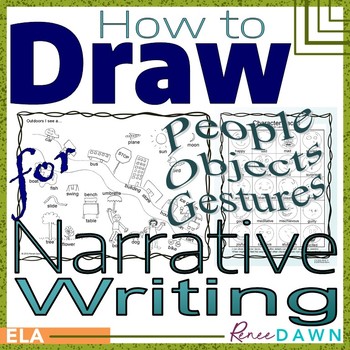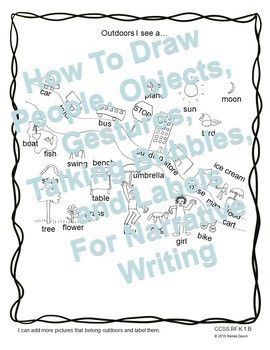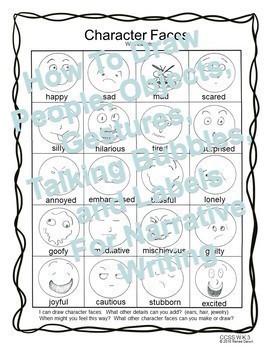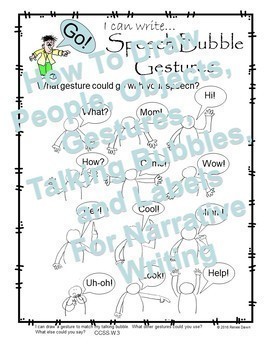How to Draw People and Objects for Narrative Writing - Directed Drawing
- PDF
- Easel Activity
What educators are saying
Description
How to draw people and familiar objects for narrative writing is perfect for your daily Writer’s Workshop Lessons, journal writing, directed drawing, distance learning, or homeschooling.
Your kids will learn to draw using simple shapes, details, facial emotions, gestures, and speech bubbles—and write about them using the prompts provided.
Save $$$ when you buy the How to Draw BUNDLE: How to Draw People, Objects, and Animals - Bundle
Do your kids constantly ask, “How do you draw a…” -- or flat-out say, “I can’t draw that!” during writing lessons? Now you can give them the tools they need for easy success. They’ll draw familiar objects and people using shapes they know.
This resource goes even further, adding charts and lessons to help kids use speech bubbles, gestures, subtle emotions, and character traits in their drawings. These are the details that make kids’ drawings sizzle!
> GREAT FOR PRINTABLES, OR FOR VIEWING ON A COMPUTER.
NEW: For Distance Learning or Classroom Computer Work:
- Pre-formatted pages--for kids to label objects or to write sentences--using TpT's Easel Tool!
- This digital tool allows kids to type and print their text, on a computer, laptop, or tablet.
- Kids may also draw a picture to go with their typed text, and share it in a real or virtual classroom.
The charts and lessons are designed to give kids maximum independence, whether they are ELLs (English Language Learners) who speak little English, or TAGs (Talented and Gifted) with highly advanced verbal skills.
These charts work wonders for early finishers. Voila! There are always more features kids can add to their drawings, and these charts will help. Kids can use the charts to help them label pictures with the beginning letters or words, or add designs to their characters’ clothing.
Ready to take your students’ writing to the next level, and have them create show-stopping illustrations? Want your bulletin boards to “pop” with eye-catching details?
Hint: it’s never too early—or too late—in the year to introduce this gift to kids. It’s the gift that keeps giving! Kids will refer to these charts all year.
What’s more, kids will add their own details as the year goes on—more objects, more fine points, and their own invented or referenced spelling.
NOT JUST FOR WRITING LESSONS! For instance, when kids make "Number Books" in Math Class, writing numbers and drawing one object, then two objects, then three objects, and so on, they can use these charts to get ideas for their artwork.
You’ll find kid-friendly lessons and charts:
- How to draw people using shapes you know
- How to draw faces
- How to draw character traits and emotions
- How to draw gestures
- How to draw gestures with matching speech bubbles
- Speech bubbles or talking bubbles: common phrases to spice up your writing
- How to add details to a drawing
- I can add shapes, pictures, designs, words, and colors to my drawing
- I can write about the details I added
- How to draw familiar objects that are indoors and outdoors
- Poster: Indoors I see a … (labeled and unlabeled)
- Poster: Outdoors I see a … (labeled and unlabeled)
- Unlabeled pictures are perfect for phonics lessons or assessment
- 2 Full Writer’s Workshop lessons
- 16 Writer’s Workshop Lesson Teaching Points
- Posters To Support Your Writing Lessons
- Tips for Differentiation, ELL, RTI, TAG, Modalities, and Early Finishers
- Writing paper with 3, 5, or 10 lines and borders for beautiful display pieces
> Glue into a writer’s notebook or place in a writer's folder for easy reference
> Enlarge for class poster
> Open the PDF on your SMARTboard for phonics lessons in labeling drawings
Common Core Aligned for K – 1, with “I can…” Learning Target and CCSS on every instructional page
• Tech Tip: you may open this PDF on a Smartboard for full class viewing, and write on it using Smartboard pens
THIS RESOURCE IS NOT CLIP ART. It is designed to help kids learn how to draw.
How to Draw Series:
How to Draw People, Objects, and Animals - Bundle
Pandemic Teaching Tips FREE GUIDE to help you teach—in the classroom, homeschool, with distance learning, or a hybrid.
- Safety Posters AND… How to use the TpT Digital Tool to convert PDF files into digital resources—for distance learning!
I hope you enjoy this How to Draw Resource…and if you would kindly leave your rating and feedback at
www.teacherspayteachers.com/ My Purchases
it would be greatly appreciated!
***** BONUS: You will get free credits to spend at TPT when you leave feedback *****
Thank you for your purchase!
© Renee Dawn
For use by one teacher per classroom; please respect the copyright.






